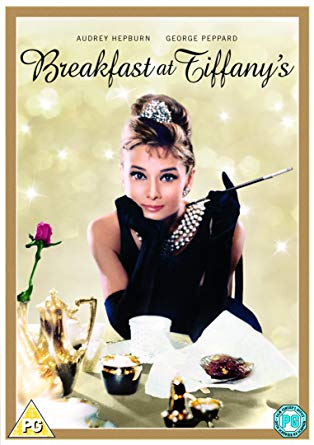
Film Review: ‘Breakfast At Tiffany’s’
Director: Blake Edwards
Starring: Audrey Hepburn, George Peppard
Genre(s): Drama, Comedy, Romance
Rating: TV-G
Runtime: 115 min
Breakfast At Tiffany’s is based on Truman Capote’s novel that is about Paul (by George Peppard), a struggling writer who is intrigued with his neighbor, Holly Golightly (by Audrey Hepburn).
Truman Capote’s “Breakfast At Tiffany’s”, whitewashed and solidified for the screen, emerges an unconventional, but dynamic, entertainment which will be talked about and commercially successful. And scenarist George Axelrod has developed a surprisingly moving positive, which is touched up into a stunningly visual motion picture experience by producers Martin Jurow and Richard Shepherd as well as surveillance of director Blake Edwards.

Capote buffs might find some fanciful alterations of Axelrod a bit too precious, pat and glossy for comfort; however, enough of the charm and vigor of the originals have been retained in order to make up for the liberties that have been taken with character to erect a marketable plot.
What makes “Breakfast At Tiffany’s” an appealing tale is Holly Golightly, its heroine with a charming, wild and amoral “free spirit” along with a latent romantic streak. Axelrod’s once-over-Golightly bloats the romanticism and erases the amorality, but retains the essential spirit of the character. Additional, in the exciting person of Audrey Hepburn, she vividly comes to life on the screen.
Particularly excellent featured characterizations are contributed by Buddy Ebsen as Miss Hepburn’s deserted husband, Patricia Neal as Peppard’s wealthy “sponsor”, and Martin Balsam as a Hollywood agent. The participation of Mickey Rooney as a much-harassed upstairs Japanese photographer also adds an unnecessarily incongruous note to the proceedings. Others valuable in support are John McGiver, Dorothy Whitney, Vilallonga, Stanley Adams, Alan Reed, and Elvia Allman. Putney, as the symbolic no-name feline pet of Miss Hepburn, is definitely PATSY bait.
Cinematically, the movie is a sleek, artistic piece of craftsmanship, especially notable for Henry Mancini’s memorably moody score and Franz F. Planer’s haunting Technicolor photography. Other ace contributions come from art directors Hal Pereira and Roland Anderson, editor Howard Smith, set decorators Sam Comer and Ray Moyer, and wardrobe designer Hubert de Givenchy.